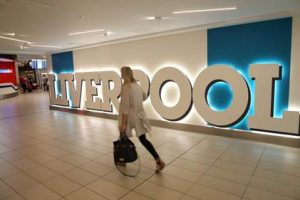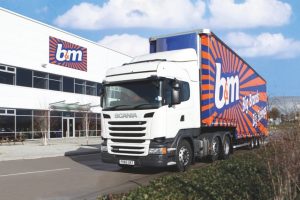Exclusive: Hub connectivity vital for LJLA

A hub link for Liverpool John Lennon Airport is at the heart of new chief executive John Irving’s ambitions for growth.
In his first interview since taking up the role last month, he told The Business Desk that international connectivity can enhance both LJLA’s leisure, and business markets.
The airport has linked with London Heathrow, and more recently, Amsterdam’s Schiphol Airport, to open up international routes for its passengers, but has so far been unable to maintain long term links with a hub operator.
And while Mr Irving has ambitious plans, including developing freight and more leisure routes, a link to a hub would be a big win for LJLA and its growth aspirations, he said.
“To have a connection through one of the major hubs … we have had it before but how do we make sure that sticks and is positive for us?” he said.
“What can we deliver from a hub connectivity point through a Frankfurt or a Dublin?
“We have got an amazing opportunity to grow here because of the market size, and what we deliver from a passenger point of view. Hub connectivity is definitely one of the things we are looking at.”
The leisure market would benefit massively, but Mr Irving believes it could also generate more business travel.
“We serve business passengers now, but if you can deliver something with connectivity, a one-ticket model, either with easyJet through an inter-line agreement or through a hub carrier, that’s obviously going to help us grow that bit of the market.
“For me a hub route has got to work from both sides. It has got to have business passengers, but with a bit of point-to-point traffic that helps the aircraft fill on the days when business isn’t necessarily strong.
“It’s definitely an opportunity, there are some amazing businesses in the local surrounds to us and in the city region, so working with those guys and understanding their needs and desires to connect, from us, ideally, is an important part of that.”
But he also insisted that the support of the business sector is vital: “It’s a combined effort. We can try and deliver routes and talk to airlines, but we need the support of business, the support of the city and regions, and the LEP (Local Enterprise Partnership), not just to deliver it, but to make it sustainable. It’s a partnership.”
He revealed talks with potential partners are taking place, but it is a lengthy process: “There’s conversations being had all the time, not just with new carriers but existing carriers.
“It’s an ongoing conversation and sometimes these conversations can last a month, sometimes they can last three or four years, it’s just making sure we keep our name in the hat and also showing people what the city is about.
“It’s a constant conversation, but we are in dialogue with a lot of people, and as that moves forward we will hopefully get something over the line.”
Mr Irving joined as the airport published its master plan for the years to 2030 and 2050. He is keen to develop the airport on several fronts.
One is freight. In the mid-1990s Liverpool carried 40,000 tonnes of freight annually, putting it in the top 10 UK airports for freight traffic, but this has dwindled to virtually zero.
Mr Irving said: “Freight is an opportunity to develop. It is an important element of what we could deliver, starting from a fairly low base. It is an ancillary revenue that every regional airport should look at.
“Delivering new routes and new carriers can bring freight to the table, but working with freight partners on the ground is definitely something we can do and the team here are starting that journey.”
Extending LJLA’s runway is also on its wish list. Mr Irving admitted: “It would be wrong of us not to have an aspiration for a longer runway which will deliver more efficient longer haul routes.”
But he said it was perhaps one for the longer term strategy: “It is one element of the multiple amount of capital investments.”
He recognises the importance of budget airlines such as easyJet, Ryanair and Wizz Air to the airport – easyJet bases eight planes at LJLA and Ryanair six – but he believes there is still room to develop more destinations for passengers.
“We’re really lucky to have easyJet and Ryanair here. They’re big strong carriers in Europe and can deliver networks across the short haul markets.
“We’ve got some good other carriers, but what else can we deliver that attracts people, over others?
“Everyone wants to go through an airport that is easy, and we definitely tick that box. It’s a friendly place. Have we got the route network that everyone wants? No. Can we deliver more? Definitely, and I think that is a key part of what an airport is for people.”
He said: “For me it’s about delivering the right destinations and route networks that we want as an airport and as a passenger.”
But he added: “I don’t think there’s anything that needs radical change, because we’re in a good place.
“The aviation market is in a good place. Passengers want to travel.
“For me it’s about growing an airport in terms of passengers and in terms of delivery back to the shareholders, and playing an important role in what is a very positive and growing city and region.”
Mr Irving took the role of LJLA chief executive on March 12, replacing previous chief executive Andrew Cornish, who resigned in June 2017.
He was previously chief commercial officer at Newcastle International Airport.
A qualified management accountant, he has also held senior commercial and financial positions at Newcastle United Football Club, and Procter & Gamble.
LJLA handled almost 5m passengers last year, slightly less than Newcastle, with flights to more than 60 destinations in the UK and across Europe.
Passenger numbers grew by almost 3% last year, compared with 2016, generating the airport’s highest annual passenger figures since 2011.
Last month LJLA launched its strategic vision to 2030, setting out how it intends to take the business forward, bringing benefits for the Liverpool City Region, the North West and North Wales.
It also incorporated the Airport Master Plan to 2050 which sets out the potential future infrastructure developments required to deliver the forecast expansion of the business, and follows last year’s public consultation of the draft airport master plan.
The strategic vision and master plan seeks to position LJLA as ‘the airport the region loves’.
It includes ambitious plans to serve more destinations, including long haul, with forecasts indicating the potential to grow passenger numbers to 7.8m by 2030.
These increases will require a planned investment of around £100m over the next 10 years, in a proposed expansion of the terminal building, additional car parking, passenger facilities including hotels, retail, food and drink services and a potential extension of the runway.
The airport says the increase in passenger throughput and investments in the its physical infrastructure has a potential to increase total annual GVA impact to £625m, and will enable it to support more than 12,000 jobs across the City Region by 2030, benefiting the wider Northern Powerhouse, too.
Increased employment, both on-site and within the Liverpool City Region, also has the potential to generate around £270m every year in additional GVA through non-aviation development.









